您好,登录后才能下订单哦!
本篇文章给大家分享的是有关怎么在Python中使用OpenCV实现轮廓的特征值,小编觉得挺实用的,因此分享给大家学习,希望大家阅读完这篇文章后可以有所收获,话不多说,跟着小编一起来看看吧。
在轮廓中,我们可以通过宽高比来描述轮廓,例如矩形的轮廓宽高比为:
宽高比=宽度/高度
下面,我们来计算矩形轮廓的宽高比,代码如下:
import cv2
img = cv2.imread("26_1.jpg")
cv2.imshow("img", img)
# 转换为灰度图像
gray = cv2.cvtColor(img, cv2.COLOR_BGR2GRAY)
ret, binary = cv2.threshold(gray, 127, 255, cv2.THRESH_BINARY)
contours, hierarchy = cv2.findContours(binary, cv2.RETR_LIST, cv2.CHAIN_APPROX_SIMPLE)
x, y, w, h = cv2.boundingRect(contours[0])
cv2.rectangle(img, (x, y), (x + w, y + h), (0, 0, 255), 3)
cv2.imshow("img1", img)
aspectRatio=float(w)/h
print(aspectRatio)
cv2.waitKey()
cv2.destroyAllWindows()运行之后,我们可以得到轮廓的宽高比约为3:

我们还可以使用轮廓面积与矩形边界面积之比Extend来描述图像及其轮廓特征,数学计算公式图下:
Extend=轮廓面积/矩形边界面积
下面,我们来计算Extend,代码如下:
import cv2
img = cv2.imread("26_1.jpg")
cv2.imshow("img", img)
# 转换为灰度图像
gray = cv2.cvtColor(img, cv2.COLOR_BGR2GRAY)
ret, binary = cv2.threshold(gray, 127, 255, cv2.THRESH_BINARY)
contours, hierarchy = cv2.findContours(binary, cv2.RETR_LIST, cv2.CHAIN_APPROX_SIMPLE)
x, y, w, h = cv2.boundingRect(contours[0])
rectArea=w*h#矩形边界面积
cntArea=cv2.contourArea(contours[0])#轮廓面积
extend=float(cntArea)/rectArea
print(extend)本例中,轮廓面积与矩形边界面积的比值Extend大约为0.8:

我们还可以使用轮廓面积与凸包面积之比Solidity来衡量图像,轮廓以及凸包的特征。其数学计算公式为:
Slidity=轮廓面积/凸包面积
下面,我们来计算Slidity,代码如下:
import cv2
img = cv2.imread("26_1.jpg")
cv2.imshow("img", img)
# 转换为灰度图像
gray = cv2.cvtColor(img, cv2.COLOR_BGR2GRAY)
ret, binary = cv2.threshold(gray, 127, 255, cv2.THRESH_BINARY)
contours, hierarchy = cv2.findContours(binary, cv2.RETR_LIST, cv2.CHAIN_APPROX_SIMPLE)
x, y, w, h = cv2.boundingRect(contours[0])
cntArea=cv2.contourArea(contours[0])#轮廓面积
hull=cv2.convexHull(contours[0])
hullArea=cv2.contourArea(hull)#凸包面积
solidity=float(cntArea)/hullArea
print(solidity)运行之后,本例轮廓面积与凸包面积的比值solidity约为1:

在OpenCV中,我们还可以使用等效直径来衡量轮廓的特征值,该值是与轮廓面积相等的圆形的直径。其数学计算公式为:
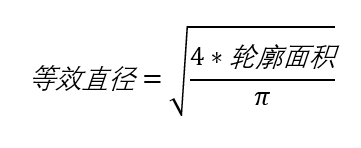
下面,我们来计算与轮廓面积相等的圆形直径,代码如下:
import cv2
import numpy as np
img = cv2.imread("26_1.jpg")
cv2.imshow("img", img)
# 转换为灰度图像
gray = cv2.cvtColor(img, cv2.COLOR_BGR2GRAY)
ret, binary = cv2.threshold(gray, 127, 255, cv2.THRESH_BINARY)
contours, hierarchy = cv2.findContours(binary, cv2.RETR_LIST, cv2.CHAIN_APPROX_SIMPLE)
x, y, w, h = cv2.boundingRect(contours[0])
cntArea=cv2.contourArea(contours[0])#轮廓面积
equiDiameter=np.sqrt(4*cntArea/np.pi)
print(equiDiameter)
cv2.circle(img,(100,100),int(equiDiameter/2),(0,255,0),3)
cv2.imshow("img1",img)
cv2.waitKey()
cv2.destroyAllWindows()运行之后,我们得到其等效直径约为145:
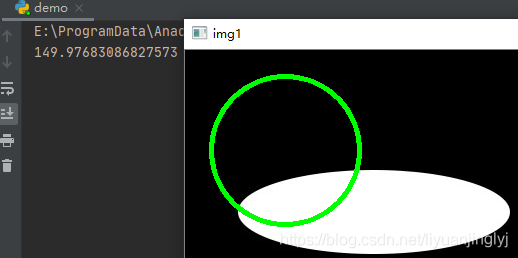
在OpenCV中,函数cv2.fitEllipse()可以用来构建最优拟合椭圆,还可以在返回值内分别返回椭圆的中心点,轴长,旋转角度信息。使用这种形式,能够直观地获取椭圆的方向等信息。
函数cv2.fitEllipse()返回值为:
(x,y):椭圆的中心点
(MA,ma):椭圆水平方向轴与垂直方向轴的长度
angle:椭圆的旋转角度
import cv2
img = cv2.imread("26_1.jpg")
cv2.imshow("img", img)
# 转换为灰度图像
gray = cv2.cvtColor(img, cv2.COLOR_BGR2GRAY)
ret, binary = cv2.threshold(gray, 127, 255, cv2.THRESH_BINARY)
contours, hierarchy = cv2.findContours(binary, cv2.RETR_LIST, cv2.CHAIN_APPROX_SIMPLE)
ellipsis=cv2.fitEllipse(contours[0])
(x, y), (MA, ma), angle = cv2.fitEllipse(contours[0])
print((x, y), (MA, ma), angle)
cv2.ellipse(img, ellipsis, (0, 255, 0), 2)
cv2.imshow("img1", img)
cv2.waitKey()
cv2.destroyAllWindows()本来就是椭圆图,下面拟合后正好也是椭圆:
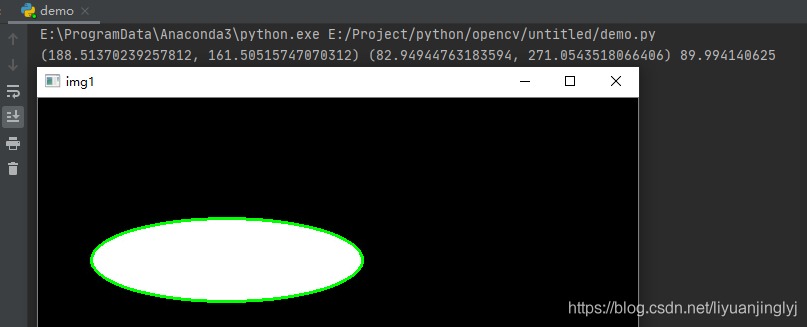
有时候,我们还像获取某对象的掩摸图像及其对应的点。在OpenCV中,它还提供了cv2.findNonZero()函数用于获取一个图像内的轮廓点位置,其完整定义如下:
def findNonZero(src, idx=None):
src:要查找非零元素的图像
idx:返回值,表示非0元素的索引位置。具体格式为(行号,列号)
下面,我们实测该函数,代码如下:
import cv2
import numpy as np
img = cv2.imread("26_1.jpg")
cv2.imshow("img", img)
# 转换为灰度图像
gray = cv2.cvtColor(img, cv2.COLOR_BGR2GRAY)
ret, binary = cv2.threshold(gray, 127, 255, cv2.THRESH_BINARY)
contours, hierarchy = cv2.findContours(binary, cv2.RETR_LIST, cv2.CHAIN_APPROX_SIMPLE)
mask=np.zeros(gray.shape,np.uint8)
cv2.drawContours(mask,[contours[0]],0,255,2)
pixelpoints=cv2.findNonZero(mask)
print(pixelpoints)
cv2.imshow("img1", mask)
cv2.waitKey()
cv2.destroyAllWindows()运行之后,我们会得到轮廓点位置:
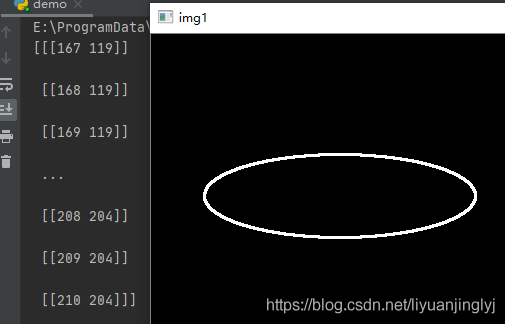
在OpenCV中,它提供cv2.minMaxLoc()函数获取指定对象内最大值,最小值以及位置等信息,其完整定义如下:
def minMaxLoc(src, mask=None):
src:单通道图像
mask:掩摸,通过使用掩摸图像,得到掩膜指定区域内的最值信息
该函数返回4个值:最小值,最大值,最小值位置,最大值位置。
下面,我们来获取这些值,代码如下:
import cv2
import numpy as np
img = cv2.imread("26_1.jpg")
cv2.imshow("img", img)
# 转换为灰度图像
gray = cv2.cvtColor(img, cv2.COLOR_BGR2GRAY)
ret, binary = cv2.threshold(gray, 127, 255, cv2.THRESH_BINARY)
contours, hierarchy = cv2.findContours(binary, cv2.RETR_LIST, cv2.CHAIN_APPROX_SIMPLE)
mask = np.zeros(gray.shape, np.uint8)
cv2.drawContours(mask, [contours[0]], 0, 255, 2)
min, max, min_loc, max_loc = cv2.minMaxLoc(gray, mask)
print(min, max, min_loc, max_loc)运行之后,控制台输出4个值:

在OpenCV中,它给我们提供cv2.mean()函数计算一个对象的平均颜色与平均灰度。其完整定义如下:
def mean(src, mask=None):
参数与上面两个小节一样,这里不在赘述。下面,我们来使用这个函数,代码如下:
import cv2
import numpy as np
img = cv2.imread("26_1.jpg")
cv2.imshow("img", img)
# 转换为灰度图像
gray = cv2.cvtColor(img, cv2.COLOR_BGR2GRAY)
ret, binary = cv2.threshold(gray, 127, 255, cv2.THRESH_BINARY)
contours, hierarchy = cv2.findContours(binary, cv2.RETR_LIST, cv2.CHAIN_APPROX_SIMPLE)
mask=np.zeros(gray.shape,np.uint8)
cv2.drawContours(mask,[contours[0]],0,255,2)
mean=cv2.mean(img,mask)运行之后,输出4个值:RGB以及A通道的均值:

有时候,我们希望获取某个对象内的极点,比如最左,最右,最上,最下等。在OpenCV中,它给我们提供了以下方法进行获取:
left=tuple(cnt[cnt[:,:,0].argmin()][0]) right=tuple(cnt[cnt[:,:,0].argmax()][0]) top=tuple(cnt[cnt[:,:,1].argmin()][0]) bottom=tuple(cnt[cnt[:,:,1].argmax()][0])
下面,我们来通过这些方法获取,代码如下:
import cv2
import numpy as np
img = cv2.imread("26_1.jpg")
cv2.imshow("img", img)
# 转换为灰度图像
gray = cv2.cvtColor(img, cv2.COLOR_BGR2GRAY)
ret, binary = cv2.threshold(gray, 127, 255, cv2.THRESH_BINARY)
contours, hierarchy = cv2.findContours(binary, cv2.RETR_LIST, cv2.CHAIN_APPROX_SIMPLE)
mask = np.zeros(img.shape, np.uint8)
cnt = contours[0]
left = tuple(cnt[cnt[:, :, 0].argmin()][0])
right = tuple(cnt[cnt[:, :, 0].argmax()][0])
top = tuple(cnt[cnt[:, :, 1].argmin()][0])
bottom = tuple(cnt[cnt[:, :, 1].argmax()][0])
print(left, right, top, bottom)
font = cv2.FONT_HERSHEY_SIMPLEX
cv2.putText(img, "left", left, font, 1, (0, 255, 0), 2)
cv2.putText(img, "right", right, font, 1, (0, 255, 0), 2)
cv2.putText(img, "top", top, font, 1, (0, 255, 0), 2)
cv2.putText(img, "bottom", bottom, font, 1, (0, 255, 0), 2)
cv2.imshow("result",img)
cv2.waitKey()
cv2.destroyAllWindows()运行之后,值与效果如下:
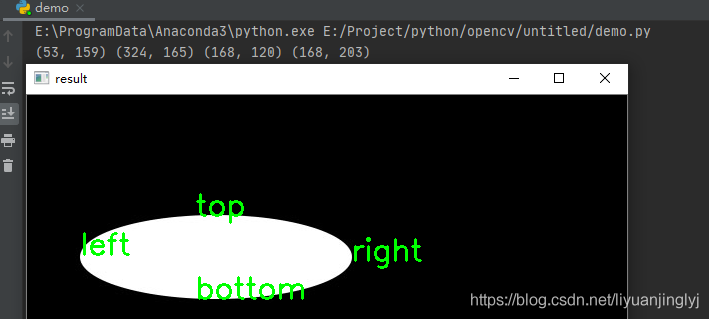
以上就是怎么在Python中使用OpenCV实现轮廓的特征值,小编相信有部分知识点可能是我们日常工作会见到或用到的。希望你能通过这篇文章学到更多知识。更多详情敬请关注亿速云行业资讯频道。
免责声明:本站发布的内容(图片、视频和文字)以原创、转载和分享为主,文章观点不代表本网站立场,如果涉及侵权请联系站长邮箱:is@yisu.com进行举报,并提供相关证据,一经查实,将立刻删除涉嫌侵权内容。